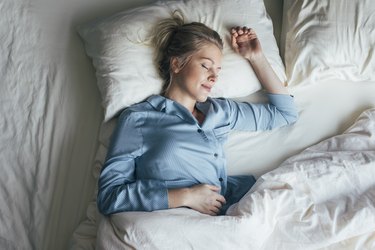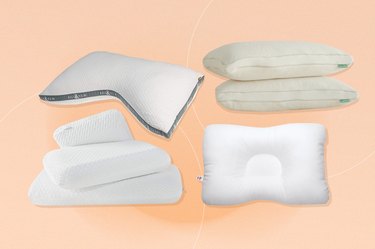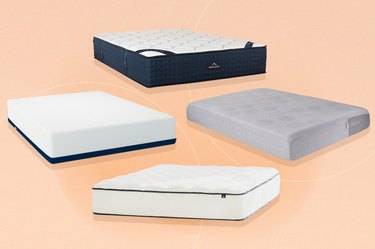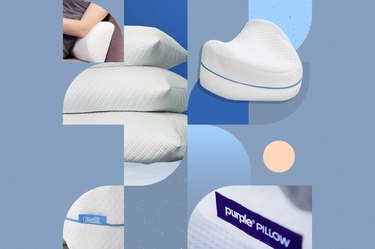
After your nightly wind-down routine, once the lights are out and it's time to drift off, you likely gravitate toward the same sleep position, night after night. You may find yourself lying on your back, sprawled on your front or curled up on one side or the other. The question is: Does this nightly choice matter?
"The short answer is it depends," says Rahul Shah, MD, a board-certified orthopedic spine and neck surgeon.
Video of the Day
Video of the Day
The goal is comfort and restful sleep, he says. "Instead of recommending a particular posture, I would recommend first judging the quality of sleep one gets," Dr. Shah says.
For some people, certain sleep positions might not make sense. For instance, anyone who snores — or sleeps beside someone who does — knows that back sleeping is often bad news.
Indeed: "Sleeping position needs tend to change with age, various health conditions and pregnancy," says Chelsie Rohrscheib, PhD, a neuroscientist and sleep specialist at Wesper.
Here, a look at the advantages — and potential drawbacks — of various nighttime positions.
1. Back (aka Supine)
"Back sleeping is better for the spine and joints," Rohrscheib says. The Cleveland Clinic deems it the "optimal sleep position" when it comes to back pain.
And it's not just about comfort.
Opting to sleep on your back "helps keep fine lines and wrinkles at bay," says Debra Jaliman, MD, board-certified NYC dermatologist, assistant professor of dermatology at Icahn School of Medicine at Mount Sinai and author of the book Skin Rules: Trade Secrets From a Top New York Dermatologist. This position is "gentler on your skin," Dr. Jaliman says, because your face isn't scrunched into a pillow.
Still, getting shut-eye on your back isn't for everyone — and it's often a poor choice for people with sleep apnea or anyone who tends to snore.
"When you sleep, the muscles that maintain the tone of the tissues in the back of your throat relax. For some people, those tissues relax too much and can cause overcrowding, which may result in snoring or the blockage of air into the lungs," Rohrscheib says.
Opt for the supine position at night, and gravity pulls those tissues even more down your throat, she says. The result: Increased chances of snoring or obstructive sleep apnea.
Don't dismiss snoring as merely a nuisance. It can be a symptom of sleep apnea, which reduces your sleep quality and can potentially lead to serious health problems, including type 2 diabetes, high blood pressure and liver problems, according to the Mayo Clinic. (That said, many people snore without having sleep apnea.)
Sleeping on your back can also trigger symptoms of gastroesophageal reflux disease (GERD), according to the GI Society. If you're committed to sleeping on your back but have acid reflux, try elevating your bed — raising it by about 6 to 8 inches is the target, according the University of Michigan Medicine.
The Bottom Line on Sleeping on Your Back
Pros | Cons |
|---|---|
Good for back pain and joints | May worsen snoring and sleep apnea |
Gentle on your skin | Can trigger acid reflux symptoms |
2. Side
For people prone to snoring, or those with sleep apnea, side sleeping is the better option, Rohrscheib says. (In fact, it's the No. 1 remedy for snoring.)
"Side sleeping is beneficial to a person's overall health, as the position does not inhibit or put any pressure on our organs," Dr. Shah says.
The position is especially ideal during pregnancy. Sleeping on your side "keeps the baby and uterus from pressing on organs and blocking circulation," Rohrscheib says. Plus, sleep-disordered breathing is common during pregnancy, per a December 2015 paper in Breathe. "Side sleeping helps to keep the airways open," Rohrscheib says.
Still: "It's not for everyone," Dr. Shah says. It can irritate the muscles holding the legs away from the pelvis, he says. Side sleeping can also lead to pressure on your shoulders and hips, potentially causing pain, Rohrscheib says.
Over time, sleeping on your side can cause fine lines that will eventually transform into wrinkles, Dr. Jaliman says.
The Bottom Line on Side Sleeping
Pros | Cons |
|---|---|
Doesn’t put pressure on organs | Can increase fine lines and wrinkles |
Can reduce snoring and sleep apnea | May cause uncomfortable pressure on joints |
Healthiest position during pregnancy |
Is One Side Better Than the Other?
In fact, yes, one side is considered advantageous. The best side to sleep on is your left.
“There is some research that shows sleeping on your left side to be most beneficial to your health,” Rohrscheib says. It may improve your circulation, she explains.
Plus, opting for your left side can ease acid reflux, per the GI Society, due to gravity and the anatomy of your stomach and esophagus.
3. Stomach
Stomach sleeping is relatively rare.
Just over 7 percent of people slept on their fronts, per one November 2017 observational study in Nature and Science of Sleep. (Most people — just over 54 percent — opted to sleep on their side, with around 38 percent sleeping on their back, per the same study.)
This is another position that isn't ideal if you're looking to avoid wrinkles, Dr. Jaliman says.
Plus: "For those who are comfortable sleeping on their stomach, the neck can sometimes be forced into an awkward posture and cause neck pain," Dr. Shah points out. And, according to the Mayo Clinic, this position "can be hard on your back." Strategic placement of pillows can help reduce these issues.
As with side sleeping, though, this position can reduce snoring and sleep apnea symptoms, according to Johns Hopkins Medicine.
The Bottom Line on Sleeping on Your Stomach
Pros | Cons |
|---|---|
Can reduce snoring and sleep apnea | Can increase fine lines and wrinkles |
May lead to back and neck pain |
Props Can Sometimes Help
If your chosen sleep position leads to some discomfort, you might consider changing to a different one (more on that in a moment). Or, consider trying some props.
Pillows
If you sleep on your side, slipping a pillow between your knees can help with alignment, Dr. Shah says.
If you sleep on your back, a pillow under your knees so they bend slightly can ease back pain and promote proper alignment, Dr. Shah says.
"Additionally, some may also experience benefits from using a pad cutout for the head, allowing the neck to be better supported," Dr. Shah says.
Silk Pillowcases
First of all, they're comfortable to sleep on, thanks to their smooth texture, Dr. Jaliman says.
They also can benefit your skin. "Silk pillowcases keep our skin hydrated due to the smoothness of the fiber....which prevents moisture from being sucked out of our skin," Dr. Jaliman says.
Switching to a silk pillowcase can help prevent fine lines and is also a good move if you have acne, she says. That's "because they are hypoallergenic and can lessen inflammation and irritation," Dr. Jaliman says. A cotton pillowcase has a rougher texture than a silk one, which could aggravate acne, she says.
Bonus: They're also a great product for hot sleepers and good for your hair, preventing frizz and reducing breakage, Dr. Jaliman says.
How to Adjust Your Sleep Position
You may very well have been sleeping on your back (or stomach, or side) since you were a toddler. So it's not always easy to switch up this habit.
Keep in mind that some adjustments might help one problem, but worsen another. For instance, sleeping supine could help with back pain but worsen acid reflux. "It may also be advisable to consult with your physician to make sure no other ailments are being overlooked," Dr. Shah says.
If you're ready to switch from one position to another, try these strategies to ease the transition:
1. Don’t Rush the Process
Take it slow, Dr. Shah recommends. Switching the habit of a lifetime takes time.
"This is because our brain loves routine, and when we dramatically switch a behavior it can cause stress and make it difficult to sleep," Rohrscheib says. Start with just one hour each night in the new position, she suggests.
"Once your body has started to feel comfortable, you can slowly extend your time in that position," Rohrscheib says.
2. Get Help From Pillows and Other Props
Positional therapy devices — such as wedges, bumpers and electronic devices — can help keep you in place, Rohrscheib says.
This doesn't need to be high-tech: For instance, the Mayo Clinic suggests sewing a tennis ball to the back of your PJs to stop you from lying on your back.
"Keep in mind that you shouldn't try to use the devices all night when you're first starting out," Rohrscheib says. Give it a few hours, then remove the device if it's uncomfortable, building your way up to a full night
If your shift is from side sleeping to supine, pillows that are only comfortable when you're on your back can be helpful, Rohrscheib says.
- Cleveland Clinic: "Is Your Sleep Position Causing You Back Pain?"
- Mayo Clinic: "Sleep apnea"
- University of Michigan Health: "GERD: Controlling Heartburn by Changing Your Habits"
- Breathe: "Sleep disordered breathing in pregnancy"
- Nature and Science of Sleep: "Sleep positions and nocturnal body movements based on free-living accelerometer recordings: association with demographics, lifestyle, and insomnia symptoms"
- Mayo Clinic: "Slide show: Sleeping positions that reduce back pain"
- Johns Hopkins Medicine: "Choosing the Best Sleep Position"
- Mayo Clinic: "Snoring"
Was this article helpful?
150 Characters Max
0/150
Thank you for sharing!
Thank you for your feedback!
Is this an emergency? If you are experiencing serious medical symptoms, please see the National Library of Medicine’s list of signs you need emergency medical attention or call 911.



